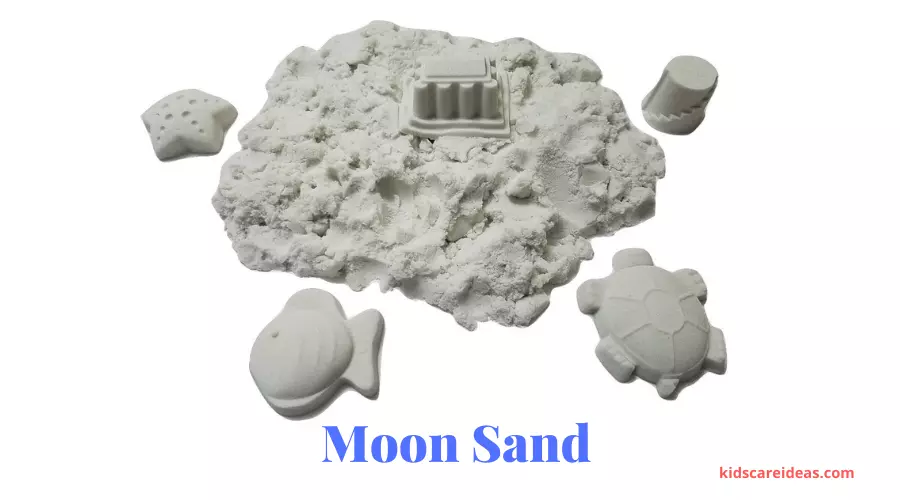Moon Sand is a very popular type of moldable play sand. Moon sand is a great sensory material and a fun toy for children.
Maybe you have heard of Moon Sand’s name, and perhaps you didn’t, but what is Moon Sand made of, and how do you make it? Is it edible? Can you eat it?
This blog gives you the important 11 things you need to know about Moon Sand.
Let’s get started!
What is Moon Sand?
Moon Sand is moldable sand that doesn’t dry out. It was given its name because it looks similar to the moon and its crumbly nature.
When compressed, it can be molded in various forms to one’s desire. It doesn’t lose its shape and hardens like clay.

It is a unique version of sand made out of a polymer, which means it is a plastic material that is sand-like.
Teachers or parents often use this unique material to provide children with a different sensory experience than traditional sand.
It is a wonderful tool for helping children with special needs improve their fine motor skills.
It is a soft material that is similar in texture to play dough.
1. Why is Moon Sand called Moon Sand?
Moon Sand is called Moon sand due to its texture and crumbliness, which resembles its surface.
Although its composition may vary, you can make moon Sand at home with play sand, corn starch, and water.
The most common recipe calls for mixing the sand and the water, then pouring them into a container.
The mixture is then left for a few days to dry. The resulting substance is similar to wet sand but crumbles easily in hand.
The corn starch acts as a binder, causing the material to hold together when dry and crumble when wet.
2. Is Moon Sand toxic?
Moon Sand is not toxic but safe for children to play with, and this is because its components are readily sourced from the kitchen and thus edible.
3. How long is Moon Sand good for?
It can stay for a month or two if kept in an airtight container at room temperature in a cool, dry place, for example, the pantry.
Discard it if it becomes dirty, gooey, or dries out.
4. Does Moon Sand go bad?
Yes, it does go bad, and this is because of the components used to make Moon Sand which is perishable.
If the Moon Sand is left open in a humid area, it will go bad.
5. Can you eat Moon Sand?
Although it is edible, non-toxic, and harmless, Moon Sand should not be eaten by adults in large quantities.
It could result in blockage of the digestive system and lead to constipation in large amounts.
6. Can babies eat Moon Sand?
Babies shouldn’t ingest Moon Sand; however, the components used to make it are not harmful to babies.
Parents and caregivers are advised to supervise the babies during playtime when playing with the Moon Sand.
If your child consumes Moon Sand, you need to quickly call your nearby doctor and follow the suggested steps by the doctor.
7. What is Moon Sand made out of?
It is a simple and unique mixture of flour (corn flour, regular flour, rice flour), food dye (optional), and vegetable oil.
8. Is Moon Sand the same as kinetic sand?
Moon Sand is not the same as kinetic sand.
Kinetic sand is regular sand mixed with silicon oil, giving a silkier texture, whereas Moon Sand is crumbly in texture.
A structure built using kinetic sand falls apart easily, but Moon Sand sticks together and doesn’t tumble.
You can check in detail the comparison of Moon Sand vs Kinetic Sand here in this article to explore the differences between the two.
9. Is eating Moon Sand harmful to dogs?
It is not harmful to dogs if ingested, for it is safe and not harmful.
However, when the Moon Sand is eaten in large amounts and gets wet, it can irritate the dog.
10. What happens if a dog eats Moon Sand?
Although it is harmless, if ingested in large quantities by the dog, the Moon Sand’s ability to bind itself with the increase of wetness will be of more concern.
This could cause an intestinal blockage for the dog, and the dog will try to vomit it out and quickly give a call to the veterinarian.
Still, if the symptoms worsen due to blockage, it will have to be taken to the veterinarian for an examination.
11. Is Moon Sand toxic to cats?
Moon Sand is not toxic to cats if ingested, for it is safe and not harmful.
However, when the Moon Sand is consumed in large quantities and gets wet in the cat’s digestive tract, it can be a little irritating to the cat.
You may consult the vet immediately and take advice.
You will notice that the cat will be trying to get it out through a gagging reflex.
Is Moon Sand Similar to Polymer Clay or Modeling Clay?
When it comes to choosing between polymer vs modeling clay, many wonder if moon sand falls into either category. Moon sand is actually quite different from both materials. While polymer clay and modeling clay are malleable and can be molded into various shapes, moon sand is more like a sensory play material that can be easily crumbled and molded, providing a unique tactile experience.
Where to Buy Moon Sand?
Moon Sand is easy to make with the ingredients at home.
However, there is fantastic Moon Sand available online on Amazon.
Conclusion
Let’s conclude the post on Moon Sand.
This type of sand has a crumbly feel, unlike the kinetic sand’s soft and stretchy feeling.
It is enjoyable to play with Moon Sand very much.
So, you can give it a try with this excellent play sand and create some creative sculptures out of Moon Sand.
I hope you got to know much about Moon Sand from this post.




